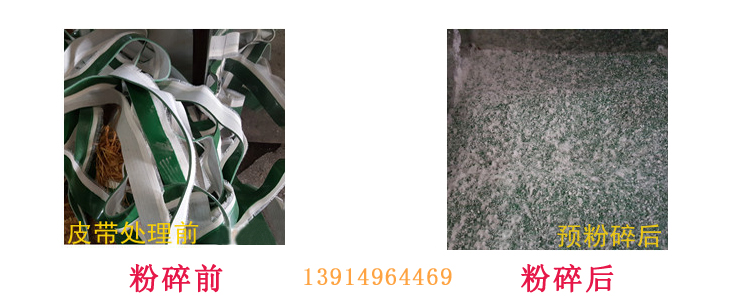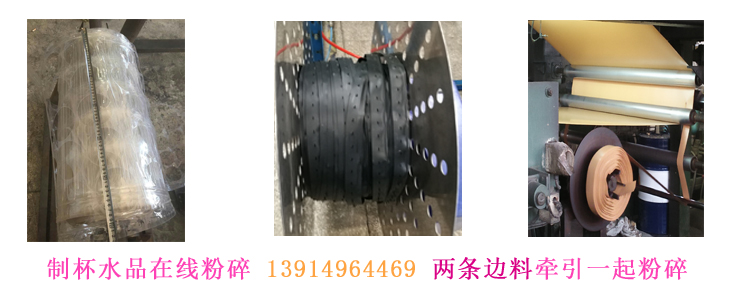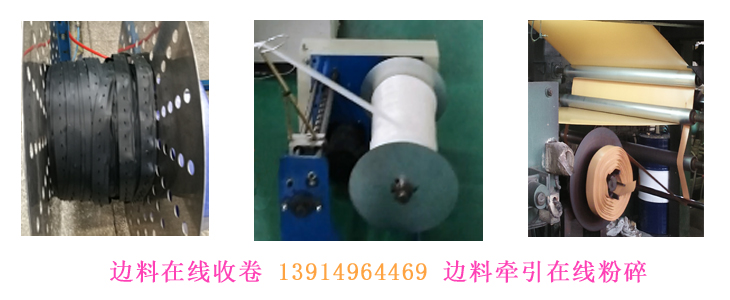|
|
|
| Waste corner plastic recycling scheme | |
|
发布时间:2017/12/26 22:26:35 点击次数:1133
The world's output of synthetic resin has reached 200 million tons, and the disposal of a large number of post-consumer plastics has become a hot spot for global environmental protection today. At present, there are several ways to deal with post-consumer plastics: 1. Landfill; 2. Incineration; 3. Composting; 4. Recycling; 5. Degradable plastics. Recycling and recycling of waste and corner plastics
Plastic recycling methods 
In order to meet the needs of protecting the earth's environment, the world's plastics processing industry has developed many new environmental protection technologies. In terms of saving resources, it is mainly to improve the aging resistance of products, prolong life, multi-functional, and design appropriate products; in terms of resource reuse, it is mainly to study the efficient sorting of plastic waste, separation technology, high-efficiency melting recycling technology, Chemical recycling technology, fully biodegradable materials, water-soluble materials, edible films; in terms of reduction technology, mainly research waste plastic compression and volume reduction technology, film bag container technology, and on the premise of ensuring application performance, try to The technology of thinning the products; in the development of CFC substitutes, it is mainly to study carbon dioxide foaming technology; in the research of substitutes, it is mainly to develop PVC and PVDC substitutes.
In the treatment of urban plastic solid waste, three methods are currently used: landfill, incineration and recycling. Due to different national conditions, countries are different. The United States mainly uses landfills, while Europe and Japan mainly use incineration. The use of landfill treatment will cause the landfill to become a soft foundation because the plastic products are generally light in quality and not easy to rot, which will be difficult to use in the future. The use of incineration treatment, due to the large heat generation of plastics, is easy to damage the furnace, and the gas generated after incineration will promote global warming, and some plastics will release harmful gases when incinerated and pollute the atmosphere. Using the method of recycling, due to labor-intensive, high recycling cost, and lack of corresponding recycling channels, currently recycling only accounts for about 15% of all plastic consumption in the world. However, due to the limited oil resources in the world, the recycling of plastics is of great significance from the perspective of saving the earth's resources. To this end, all countries in the world have invested a lot of manpower and material resources to develop key technologies for the recycling of various waste plastics, and are committed to reducing the cost of plastic recycling and developing its suitable application areas.
heat recovery method
Most plastics are made of petroleum, and the main component is hydrocarbons, which can be burned, such as polystyrene, which burns more heat than dye oil. Some experts believe that sending plastic waste into incinerators to burn can provide heat for heating or power generation, because 86% of petroleum dyes are directly burned, and only 4% of them are made into plastic products. After the plastic is used up, it will be sent to heat energy. Burning is normal, and thermal energy use is one of the last ways to recycle plastics and should not be taken lightly. But many environmental groups oppose the burning of plastics, arguing that the incineration method, which concentrates all the chemicals in a mess, produces toxic gases. For example, half of the PVC composition is chlorine, and the chlorine gas released during combustion has strong erosive and destructive power, and is the culprit of oxin.
At present, Germany has 200,000 tons of PVC waste every year, of which 30% is burned in incinerators, which burns people in panic, and the law has to formulate countermeasures. The German Federal Environment Agency has stipulated that all incinerators must comply with a limit of less than 0.1ng (nanogram) per cubic meter of exhaust gas. Although the German air pollution standard for incinerators is a recognized standard in the world, it still does not dare to say that the combustion method will not release harmful substances due to mechanical failure. Therefore, it is foreseeable that environmental protection groups in various countries will still vigorously oppose the recovery of heat energy by incineration.
Sorting and recycling method
As plastic recycling, the most important thing is to sort it. Common plastics include polystyrene, polypropylene, low-density polyethylene, high-density polyethylene, polycarbonate, polyvinyl chloride, polyamide, polyurethane, etc. The difference between these plastics is difficult for ordinary people to distinguish. Most of the current plastic sorting work is done manually. Recently, there has been new research progress in machine classification. A chemical technology association in Germany invented the use of infrared to identify categories, which is fast and accurate, but the sorting cost is high.
chemical reduction
Researchers are trying to distill the chemicals inside the plastic so that it can be reused. The technological method used is to cut off the long chain of the polymer to restore its original properties, and the cracked raw materials can be used to make new plastics. Some methods are to promote the chemical cracking of combined carbon atoms by adding chemical elements, or adding energy to promote their thermal cracking.
The German Bayer company developed a hydrolysis chemical reduction method to crack the PUC sponge pad. Tests have shown that chemical reduction is technically feasible, but it can only be used to process clean plastics, such as corner powder and other plastic waste from the manufacturing process. And the plastic used in the family that is contaminated with other contaminants is difficult to dispose of by chemical decomposition. The application of this reduction method will not be widely used until the 21st century to treat waste by hydrolysis. Some new chemical decomposition methods are still in the research process. Ford Motor Company of the United States is currently applying ester hydrolysis to the treatment of automobile waste plastic parts. Lense Institute of Technology in the United States has developed a solution for decomposing plastic waste, heating the patented solution with six different types of plastic mixed together. At different temperatures, 6 polymers can be extracted separately. In the experiment, polystyrene plastic fragments and related solutions were mixed into a dissolved state at room temperature, sent to a sealed container for heating, and then sent to a "flash chamber" with a lower pressure, and the solution evaporated rapidly (can be recycling), the rest is virgin polystyrene that can be reused. It is said that the purification device used in the study can purify 1kg of polymer per hour. New York State Government and Niagara. Mohawk Power is planning to join forces to build a small pilot plant. Investors claim that the plant will be able to recycle 4t of polymer raw material per hour after completion. Its cost is only 30% of the production raw materials, and it has very obvious commercial value.
Reduced class design
The research and development department takes into account the need for recycling and disassembly when designing products. For materials suitable for recycling in the United States, the focus is not on which plastic should be used to make individual parts, but on materials that can be widely used. , which is a revolutionary shift in conception.
In order to facilitate recycling, designers began to avoid using a variety of plastics when designing products. BMW of the United States plans to reduce the types of plastics by 40% in its new car design, in order to facilitate the recycling of waste plastics. The reason why the automobile industry reduces the types of plastics used and considers additional charges in the design is mainly to win a good image of attaching importance to environmental protection and to be appreciated by consumers. At present, this design concept is gradually infecting the entire plastics processing industry. However, efforts from all sides have still not been able to eliminate any of the 20 types of plastics on the market. After all, the diversity of products has led to the ever-changing types of plastics. For example, the plastics used in the production of electronic computers are not the same as those used in the production of automobiles. To this end, experts suggest to formulate relevant recycling standards, stipulating that special industries can only use specified materials, otherwise effective recycling cannot be controlled. Both the electronics and automotive industries have begun to formulate such standards. The world's electrical and electronic market has paid attention to the recycling of waste plastics. International Business Machines Corporation (IBM) has begun to code the plastic parts of computers and business machines, and is developing recyclable plastic electronic parts and simplifying disassembly equipment. The product structure is also considered to cancel the surface coloring of the components, control the amount of external adhesives of plastic additives, and reduce the use of non-recycled process parts and additional parts. The recycling of waste auto parts has also made great progress. Many countries take recyclable and easy recycling as the premise of the selection of raw materials and product design of auto plastic parts. Some countries have developed effective standard recycling numbers and recycling schemes for automotive plastics, and are considering developing a uniform marking system to aid in the dismantling and sorting of automotive plastics. Countries such as Europe and the United States are also studying the chemical depolymerization method to recycle automobile plastics.
Biodegradation
While actively developing plastic recycling technology, research and development of biodegradation has become a research hotspot in plastic processing industries around the world. Researchers hope to develop a plastic that can be degraded in a microbial environment to deal with the pollution of large quantities of single-use plastics, especially mulch and multi-packaging wastes on farmland, forests, and oceans. The research goal is to develop a plastic that can guarantee its performance during use, and can be decomposed by microorganisms in the environment once it is used up and discarded, thereby completely entering the ecological cycle. At the same time, the production cost of this plastic is relatively low, and it has corresponding economics. If such biodegradable plastics are used, they can be composted with normal bio-waste without the costly collection, sorting and recycling process. Moreover, the decomposition products enter the ecological cycle and do not cause waste of resources.
In the research and development of biodegradable plastics, countries around the world have invested a lot of money and manpower, and spent a lot of energy on research. The plastics processing industry generally believes that biodegradable plastics are a new technology topic in the 21st century. In the late 1980s, in order to solve the problem of the degradation of garbage bags, under the promotion of American corn merchants, polyethylene plastic bags added with starch were popular in Europe and the United States as biodegradable plastics. However, because the polyethylene in it cannot be degraded, its application research has been greatly cooled. Just because the raw materials of starch are abundant and cheap, many researchers are still engaged in research in this area, hoping to make breakthroughs in degradability through various formulation technologies. The technical routes currently developed mainly include microbial fermentation synthesis method, chemical synthesis method using natural polymer (cellulose, lignin, chitin) synthesis method, etc., and some water-soluble resins for biodegradable plastics have been developed, but the general In other words, its production cost has not reached the requirements of industrialized mass production. After years of research, experts in the research of fiber products from the German Bayer company have made a plastic that can be completely decomposed into humus. The packaging film made of this plastic can quickly decompose "disintegrate" in the soil, and can return to nature within 10 days. According to the identification of environmental protection organizations, this plastic and its decomposed neutralizer are safe and reliable for the environment and human beings. The new type of plastic developed by the company is made by mixing hard and not easily extensible cellulose with polyurethane. After burying this new type of plastic in the soil, it can become a delicious food for microorganisms in the soil, and the rapidly multiplying microorganisms can quickly completely digest the material into humus. 
A household plastic wrap made from this material is fully powdered after 14 days and loses 80% of its weight after 8 weeks. This material is used to make a nutrient bowl for the culture, and after being planted in the soil for several weeks, it is homogenized into humus and acts as a compost. Because the production cost of this new technology is too high. It is several times that of ordinary plastics, so it is difficult to achieve commercial production at present.
In terms of application experiments, after years of hard work, my country has achieved initial success in the research project of biodegradable polyethylene plastic film, developed biodegradable plastic film samples, and carried out small-scale trials. From the perspective of its technical maturity , has not yet reached the level of widespread application. my country has not yet set foot in the field of additive photodegradable plastics. The United States has used photodegradable plastics for lifting rings for bottled beverages for many years, and Israel and Canada have tried photodegradable plastic films, but there are no reports of large-scale applications. It is predicted that if the industrialization research of biodegradable plastics is counted as 100, the current development research is only at a relative stage of 30. It is expected that after 2000, industrialization is expected to be realized. At present, the United States is in a leading position in the development and research of this technology, followed by Europe and Japan.
Recycling and recycling of waste and corner plastics
In general, there are still many problems to be overcome in the research and development of biodegradable plastics. First, there is no consensus on the definition of plastic degradation, i.e. what exactly does biodegradation mean? That is to say, how long is the decomposition time of biodegradable plastics determined? Also, what should be the products of decomposition? Are the final products carbon dioxide and water, or any form of residue that is not detrimental to the actual application? Secondly, there is no universally recognized unified method for the evaluation test of biodegradable plastics. At present, the American Society for Testing and Materials, the Japan Industrial Standards Association and the International Organization for Standardization are all actively carrying out this work. Although the American ASTM has officially issued a number of results, they cannot be fully applied to the treatment of actual plastic waste.
|

中文CN

Service hotline:
137-7631-9563








